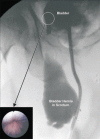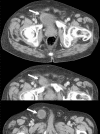Inguinoscrotal bladder hernias: report of a series and review of the literature
- PMID: 19066682
- PMCID: PMC2593594
- DOI: 10.5489/cuaj.980
Inguinoscrotal bladder hernias: report of a series and review of the literature
Abstract
Bladder involvement occurs in 1%-4% of cases of inguinal hernias. Among obese men aged 50 to 70, the incidence may reach 10%.1,2 The diagnosis of bladder involvement is often difficult to delineate at the time of presentation and may only become apparent at the time of herniorrhaphy. Surgical management pertaining to the approach, repair and potential need for bladder resection may challenge the surgeon. We report a series of 4 cases of large inguinoscrotal bladder hernias and provide a literature review. Our goal is to highlight the clinical presentation and the decisive issues surrounding the diagnosis and management of this condition.
Figures




References
-
- Fisher PC, Hollenbeck BK, Montgomery JS, et al. Inguinal bladder hernia masking bowel ischemia. Urology. 2004;63:175–6. - PubMed
-
- Huerta S, Fairbanks T, Cinat M. Incarcerated vesicoinguinal hernia presenting with gross hematuria. J Am Coll Surg. 2005;201:992–3. - PubMed
-
- Shelef I, Farber B, Hertzanu Y. Massive bladder hernia: ultrasonographic imaging in two cases. Br J Urol. 1998;81:492–3. - PubMed
-
- Laniewski PJ, Watters GR, Tomlinson P. Herniation of the bladder trigone into an inguinal hernia causing acute urinary obstruction and acute renal failure. J Urol. 1996;156:1438–9. - PubMed
-
- Vindlacheruvu RR, Zayyan K, Burgess NA, et al. Extensive bladder infarction in a strangulated inguinal hernia. Br J Urol. 1996;77:926–7. - PubMed
LinkOut - more resources
Full Text Sources
